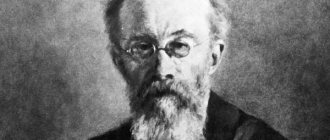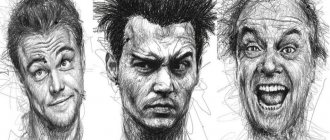What is character
This concept itself appeared in the era of Antiquity and comes from the Greek word “imprint”. Indeed, character manifests itself in a person’s behavior and leaves an imprint on him, making him unique and recognizable. And the stronger the character, the more vivid and unique the results of the individual’s activities are. But a person who is deprived of this power, that is, that inner “I” that controls behavior, is often called characterless. Not in the sense that he has no character, but because his actions are determined by external circumstances, and not by internal beliefs and moral qualities.
Character is a complex system of personality traits and qualities, so their combination and degree of expressiveness make each person unique. The character traits that make up its structure are usually divided into two large groups:
- biologically given (innate);
- formed in the process of personality development (acquired).
Biological basis of character structure
The basis of character is the innate characteristics of higher nervous activity:
- speed of nervous processes;
- the strength of these processes;
- the ratio of excitation and inhibition in the nervous system.
The combination of these features constitutes the temperament or type of higher nervous activity of a person. There are only 4 types of temperament (phlegmatic, melancholic, sanguine and choleric), but in their pure form they are practically never found. These are complexes of traits, features of higher nervous activity that are present in humans in different combinations and varying degrees of severity. That is, if we take, for example, such a paired characteristic as introversion-extroversion, then a person can be more or less an extrovert or an introvert.
And there are several such characteristics that make up temperament. For example:
- rigidity and plasticity;
- emotional stability and emotional imbalance, sensitivity (sensitiveness), etc.
Due to their combination, a unique biological basis for character is created, and in the process of its formation, innate individual psychological traits are melted under the influence of the environment, mixed with social qualities, acquired properties, characteristics, and a completely unique personality is created.
Character and its physiological basis
Character is the second individual psychological property of a person. Translated from Greek, this word means “minting”, “sign”, “sign”. If in temperament a personality is revealed from the side of its dynamic manifestations, then in character - from the side of its content. Character is determined by socio-historical conditions - belonging to an era, nation, class, assimilation of social experience, typical circumstances of life's path, upbringing, depends on the natural prerequisites for the development of individual inclinations, the type of higher nervous activity, temperament, which determines its external form of expression, imposing a peculiar imprint on certain manifestations of character.
Knowing the essential characteristics of a person, expressed in character, allows us to some extent predict how he will act in certain situations. Character is the basis of personality, its core, the significance of which is extremely great. This is reflected in folk wisdom, which says: “If you sow an action, you will reap a habit; if you sow a habit, you will reap a character; if you sow a character, you will reap a destiny.” These words emphasize the organic interrelation of individual actions, character and general life line of a person. A person’s life activity, his successes and failures largely depend on his character traits. Positive character traits help overcome difficulties, influence the life and work of the team, and people’s mood. People are highly moral, friendly, establish friendly relationships well, cooperate successfully, stimulate the life of the team, make it full-blooded and interesting. And, on the contrary, a person with a “difficult” character is gloomy, embittered, quarrelsome - interferes with the life of the entire team, creates an atmosphere of tension, nervousness, irritability, and conflict situations. Character is formed in the family and society, but it manifests itself in a person in different ways, depending on his interests, abilities, feelings, motives, level of aspirations, i.e. those “internal conditions” according to S.L. Rubinstein, through which all external influences are refracted, which creates the individuality of the individual.
The individual and the general in character form a unity. Character is both “stable” and “changing.” On the one hand, the individual uniqueness of the life path of each individual person forms the diversity of individual traits and its manifestations. On the other hand, the general circumstances of life of people living in the same social conditions form common character traits.
The physiological basis of character is, on the one hand, the type of nervous system (GNI type), on the other, a system of temporary connections that arise under the influence of external influences. The properties of the nervous system determine in it such features as balance or imbalance, greater mobility or inertia, increased or decreased tone of activity, sociability or isolation, ease or difficulty of entering a new environment or new responsibility. The type of GNI also affects other manifestations of character, for example, the tone of feelings, the external expressiveness of movements, and speech. It affects manifestations of will (in the form of impulses or evenly, methodically), and manifests itself in the ability to perform work that requires patience and endurance. But the type of nervous system does not predetermine the content of either the personality as a whole or individual traits of its character. Thus, passionate, impetuous persistence is formed more quickly and easily in a person with an unbalanced type of nervous system, on the contrary, a calm, slow manner of behavior more often arises on the basis of the balance of the nervous processes of excitation and inhibition.
Character in many ways is a skill of conscious behavior and habits. Therefore, its physiological mechanisms include dynamic stereotypes that arise in the brain - systems of temporary connections, conditioned reflexes. The resulting stereotypes ensure typical behavior in typical circumstances. Breaking a stereotype is difficult and sometimes very painful. Changing your usual lifestyle, stopping your usual activities, or losing a loved one can lead to significant changes in your personality. The components of the physiological foundations of personality are also the individual interaction of the first and second signaling systems and the features of the analytical and synthetic activity of the cerebral cortex.
Character cannot be identified with temperament, and at the same time they are closely interrelated. Temperament colors character traits in its own way and gives them unique forms; character can also deeply influence temperament, subordinating emotional excitability to the content side of the personality, its orientation and will. A person’s character is also interconnected with other aspects of the personality: intelligence, special abilities, worldview, beliefs, moral principles, etc., it is multifaceted and diverse in its manifestations. Depending on the specific tasks that a person solves, as well as on the state of the body, one or the other character traits may be manifested or inhibited. At the same time, he is complete. Integrity is achieved by the core, most stable, dominant in strength and activity traits.
Character Structure
IN
it is based on several groups of traits that express the system of personality relationships.
The first group
includes traits that express the individual’s attitude to reality and society. This group of traits is based on the orientation of the individual, a system of leading motives. Direction, as the most important aspect of character, is a uniquely experienced selective attitude towards reality, which has a certain content and certain psychological forms. These include: attention, interest, human ideals, feelings.
Second group
constitute traits that are manifested in work and activity: initiative, diligence, efficiency, diligence, conscientiousness, responsibility, creative attitude (or opposite traits), etc.
Third group
trait expresses a person’s attitude towards other people: goodwill, sensitivity, tact, politeness, truthfulness, sincerity, humanity (or the opposite traits), etc. The basis of this group is an empathic or indifferent attitude towards people.
Fourth group
- this is a system of a person’s relationship to himself: self-criticism, modesty, pride, self-confidence, pride, egocentrism, self-control, dignity, severity, etc.
Fifth group
includes traits that characterize a person’s attitude towards things: neatness, sloppiness, frugality, generosity, stinginess, wastefulness, etc.
Character is inextricably linked with a selective attitude towards the environment; it is a specific combination of attitudes towards society, nature, other people, and oneself. Like the entire mental life of people, relationships with the environment are deeply dynamic, dependent on changes occurring outside, in life, in human activity; some relationships are replaced by others - relationships of a different level. Character is a personal characteristic, largely determined by the socio-historical conditions of a person’s life, primarily by the social environment around him. At different age stages, its formation occurs in different ways, depending on life experience, living conditions, prevailing forms of activity, conditions of education and self-education.
The formation of character begins in childhood and largely depends on the environment with which the child interacts. The system of constantly increasing the complexity of demands on the part of adults is of decisive importance for the formation of positive character traits. An essential point is the objectivity of the assessment of the child’s actions and actions. His profession leaves its mark on individual psychological characteristics and, first of all, on a person’s character. In this sense, they talk about the professional character of a teacher, doctor, artist, actor, military man, etc.
Character structure: socially determined traits
Along with the innate, biologically given basis, character includes personality traits that are formed under the influence of society in the process of education and self-education, development and self-development.
Here it must be especially emphasized that a person is not a passive object of influence from society. He actively interacts with the environment, passes through himself everything that he receives from the surrounding reality, melts it in his inner world, and on the basis of this transformed experience his character is formed. Therefore, it is completely wrong to blame society (family, school, society as a whole) for shortcomings of one’s own character. We create ourselves and are responsible for both our positive and negative qualities. Proof of this is the example of children with completely different characters growing up in the same family.
Character has a rather complex structure, in which, along with the biological basis, there are 4 groups of qualities that are formed under the influence of the social environment.
Moral traits
Moral or ethical qualities of an individual are associated with socially accepted norms of behavior, values, ideals and attitudes. Moral character traits are revealed:
- in the social sphere;
- in communicating with people;
- in relation to them and to socially significant values.
The formation of these character traits is a complex process that occurs not only under the influence of a person’s immediate environment, but also under the influence of the media, fiction, traditions, beliefs and legends.
The variety of channels of influence and a person’s active interaction with them, as well as the uniqueness of his individual psychological makeup, provide a unique set of moral traits inherent in each person. Among the most significant are the following positive moral qualities:
- sense of duty – the ability to subordinate one’s personal desires to the needs of society;
- justice - the ability to distinguish between good and evil and the desire to protect good and fight against evil;
- honesty - loyalty to one’s obligations, the pursuit of truth, rejection of lies in one’s behavior;
- politeness - respect for other people, adherence to norms of behavior towards each member of society, regardless of social status or age;
- devotion - loyalty to another person, society, ideals, manifested even in the most difficult circumstances;
- friendliness is the ability not only to respect people, but also to have positive feelings towards them, a desire to support and help.
These are just the most basic positive moral qualities, in fact there are much more of them, you can continue this list yourself. Along with the positive ones, there are also negative traits, of which there are also many:
- deceit;
- coarseness;
- impudence;
- meanness;
- cowardice;
- greed, etc.
There are no perfect people. The peculiarity of the character of any person is that he may contain both positive and negative qualities, manifesting himself in different situations, creating a unique, individual appearance of a person. For example, a man who bravely rushes to save people from a burning building may be desperately afraid of going to the dentist.
Emotional Traits
The emotional qualities of a person are largely determined by the properties of temperament. For example, the increased excitability and expressiveness of a choleric person creates a peculiar emotional background, which is characterized by mood swings, falling in love, hot temper or excessive cheerfulness. On the other hand, in the process of education, serious attention is paid to developing the ability to restrain one’s emotions and control them.
Therefore, emotional traits are largely determined by the social factor and the corresponding norms of behavior accepted in society. For example, the excessive (in our opinion) emotionality of Italians is completely tolerated by their culture. But in Japan, open demonstration of one's emotions is considered not very decent.
The variety of manifestations of human emotions also determines the variety of emotional traits. Unlike moral qualities, it is difficult to distinguish between positive and negative ones among emotional ones. It's all about the degree to which these traits are manifested and their appropriateness. Agree, cheerfulness at a wedding is normal and even welcomed, but at a funeral it looks clearly indecent.
The following are the most common emotional personality traits:
- sensuality;
- passion;
- cold;
- cheerfulness;
- gloominess;
- amorousness;
- impressionability;
- restraint;
- aggressiveness;
- timidity, etc.
The manifestation of a person’s emotional qualities is largely related to the need for communication, therefore, less sociable introverts have a set of these qualities and their expression that differs from the extroverted personality type.
Strong-willed traits
The success of a person’s activities and how he is assessed in society largely depend on his ability to regulate and organize his behavior, that is, on his volitional qualities. They allow you to smooth out and overcome such negative character traits as laziness, timidity, shyness, indecisiveness, etc.
Volitional qualities are cultivated from childhood, formed under the influence of society and are closely related to the awareness of the need to subordinate one’s freedom to the demands of society. Will largely determines both the degree of a person’s activity and his ability to restrain himself. Most psychologists consider volitional qualities to be basic personality traits that largely determine the content of one’s character.
The leading volitional qualities include the following:
- endurance – the ability to restrain one’s emotions and impulsive actions;
- patience - the ability to maintain a high intensity of activity through volitional effort, despite fatigue or illness;
- purposefulness – conscious goal setting and the ability to achieve it;
- integrity – having stable principles and following them in any situation;
- independence – the ability to make independent decisions and organize activities to implement them;
- responsibility for one’s activities, behavior, ideas, etc.
There are many more strong-willed qualities than are listed here, but even these basic ones prove how significant this area of character is for a person.
Intellectual traits
Intellectual qualities of character are what distinguishes our cognitive activity and leaves an imprint on all aspects of the personality. Because these are not only mental abilities and qualities of attention and memory, but also interests, hobbies, and the direction of cognitive activity.
Intellectual traits largely determine a person’s ability to master new types of activities and the ability to independently organize the process of cognition. Basic intellectual traits include the following:
- qualities of thinking (level of intelligence, flexibility, creativity or standardization, logic, intuitiveness, etc.);
- curiosity – the need for new knowledge;
- resourcefulness - the ability to quickly find an answer to a complex question;
- intelligence;
- thoughtfulness;
- frivolity, etc.
Intellectual qualities not only influence all other character traits, but also participate in creating a unique image of a person. It’s not for nothing that they say: “You meet by your clothes, but you see off by your mind.”
Chapter
XI
BIOLOGICAL FOUNDATIONS OF PERSONALITY
This section of psychological knowledge plays a big role in the formation of a doctor’s holistic views. A holistic approach is one of the most important elements of an adequate view of a person ( holism
- this is the unity of the human psyche and body in all psychological and psychopathological phenomena). The concept of “holism” can be expanded to understand the unity of man, his biology, his psyche and the world around him. Since ancient times, attempts have been made to connect the structural features of the human body as a biological basis with the characteristics of human character. The famous classification of Hippocrates, identifying four main types of human temperament - choleric, sanguine, phlegmatic and melancholic - was essentially a holistic typology, since it connected the characteristics of human character with the functioning of bile - a purely biological substrate. And various combinations of proportions of black and yellow bile resulted in one or another character (temperament).
This classification turned out to be so adequate to the order of medicine that to this day these four main types of temperament are firmly held in the terminology of medicine, at least in domestic medicine. This is due to the fact that domestic medicine received support for this typology by the work of the Pavlovian school, where the same four types of temperament were also identified, but in them the presence of certain characteristics was no longer associated with the properties of bile, but with the properties of the nervous system, with the mobility or inertia of the nervous system. processes with a predominance of excitation or inhibition processes. Here the body seemed to recede into the background and the main thing became the connection between temperament and the properties of the nervous system.
Very often, in his medical practice, the author had to deal with precisely this idea of a person’s personality among doctors who graduated from medical school (in the course of the subjects that students study, this section does not occupy a leading place). But this idea is nonetheless dominant. An internist, making an order to a medical psychologist to solve some psychological problems of patients with somatic diseases, formulates in this order, as a rule, an orientation towards the study of temperament. Let's try to understand why, out of all the knowledge about human psychology, only these four temperaments remain in the head of even a talented and educated internist. Yes, maybe because this design is so established. It has existed since ancient times and is already a cognitive map of people, because, without yet studying medicine, a person hears such expressions as “phlegmatic”, “choleric”, “melancholic”, because these terms are used by teachers, parents, and social environment of a person. This design of temperaments has become so widespread in life that it dominates and overshadows all other characteristics of a person’s personality.
These four basic temperaments are described by Galen (although he described more - nine temperaments, but four became basic).
Sanguine
The main aspiration is an orientation towards pleasure, combined with a slight excitability of feelings, but these feelings are short-lived.
He is carried away by everything that is pleasant, his inclinations are fickle, and one should not particularly rely on them. He is trusting, gullible, loves to create some projects, but never completes them. It is interesting that when these four types were described according to Galen, many portrait artists practically reproduced a person with such a temperament. A sanguine person was usually depicted as a rosy-cheeked, round-faced, good-natured, smiling lively person, i.e. There has already been an attempt to connect personality traits with
body structure.
Choleric
is influenced by passions and displays remarkable strength and energy in activities in which he is very persistent. He quickly ignites from every obstacle, his feelings - pride, vindictiveness, ambition - practically know no limit when the soul is under the influence of passion. He is not inclined to think and acts quickly, almost without thinking.
A phlegmatic person
feelings arise slowly, he does not have to make much effort to maintain his composure, it is easier for him than for others to restrain himself from making quick, rash decisions. It is difficult to irritate him, he rarely complains, he endures his suffering patiently, and the suffering of other people does not cause a strong emotional response.
The main dominant characteristic of a melancholic person
is a tendency towards sadness. He often thinks that he is neglected, starting from childhood, he is vulnerable. Even small failures cause him grief. He perceives life as suffering. Like a choleric person, he reacts quickly and with sparkling eyes to stimuli. A melancholic person was usually depicted as a pale man with a thin, narrow face, immersed in himself, in his sadness.
It may be that, trying to depict types of temperaments, artists intuitively drew such specific typological characteristics of the body, and served as the basis for the creation of typologies in which the emphasis was placed specifically on the structure of the human body.
The very first of this kind of typologies is the typology of Ernst Kretschmer, created by him in the early 20s. He identified the following constitutional types:
1. Asthenic – a person of tall stature, fragile build, reduced transverse dimensions, flat chest, long, elongated face, long and thin nose. He has narrow shoulders and long legs.
2. Average type - athletic - a person of tall or average height with a strong, proportional physique, good muscles, a wide shoulder girdle, narrow hips and convex facial bones (protruding chin, cheekbones).
3. The polar asthenic type - picnic - a person of small or medium height, obese, overweight, barrel-shaped chest, large belly, with a rather large round head on a short neck, he has a round face with soft features.
In identifying these types, several attempts were made, including by Kretschmer himself, to connect the typology of the constitution with certain character traits and not so much with character traits, but with the prevailing mental pathology. This even led to the transformation of the names of these constitutional types, when asthenics were called schizoid, and picnics - cycloid, since a certain correlation was found between the frequency of asthenics with schizophrenia, and picnics with manic-depressive psychosis.
An attempt was also made to connect constitutional typologies with typologies of another series, no longer associated with the biological aspects of the human body, for example, an attempt to combine two typologies - the typology of E. Kretschmer and the typology of K. Jung. C. Jung divided people into three large groups:
1. Introverts
– people focused on their inner world, closed, not very sociable, emotionally vulnerable, sensitive, prone to long-term experiences of failures and self-analysis, in which self-esteem is often low.
2. Extrovert
- a sociable, lively, open person with a quick transition of feelings, drawn to people, easily falling into joy and sadness, although it passes quickly. If an introvert is closed and closed, then an extrovert is open, talkative and not prone to introspection. An extrovert is oriented, unlike an introvert, to the outside world.
An introverted character was associated with an asthenic physique, and a picnic physique with an extroverted personality.
3. Ambivert
- a person who combines both qualities, as if the most harmonious, proportional, balanced type, which was associated with the athletic constitutional type.
E. Kretschmer in his works, establishing connections between body structure and character, found relationships between mental properties, human characteristics, in particular, between the structural features of the body and the functioning of the endocrine glands and human character. Lack of thyroid function simultaneously causes a smoothing of temperament (“dulling”) and stunted growth, simultaneously affecting a person’s intellectual development. Removal of the seminal glands (early castration) creates a phlegmatic temperament characterized by weak impulses and, in parallel with this, a special (so-called eunuchoid) body structure - with excessively long limbs and a sharply changed type of hair growth. Therefore, Kretschmer largely connected the characteristics of the human psyche not only with the structure of the body, but also with the characteristics of the functioning of the endocrine glands. He made a number of findings related to the peculiarities of the functioning of the endocrine glands, and created a typology of dysplastic groups with disruption of the endocrine system:
- tall eunuchoid;
- eunuchoid forms of obesity;
- infantile and hypoplastic forms of body structure. Another important section of this chapter is the connection between the characteristics of the psyche and the development of the body, with its proportionality, that is, the doctrine of dysontogenesis, in the development of which much credit belongs to the famous child psychiatrist Vladimir Viktorovich Kovalev and the works of his colleagues and students. Various forms of dysontogenesis are disturbances in the proportionality of the body that arose both in the genetic and prenatal periods, as a result of exogenous and endogenous causes.
This is how E. Kretschmer describes these types (they are aimed at men).
— Picnics
(in middle age) - these are people with short limbs, stooped, well-fed, with a tendency towards a fresh complexion. The bones are fragile, the muscles are weak and the fat covering of the face, neck and torso is abundant. They have a voluminous head, chest and belly. Narrow, set shoulders and a barrel-shaped body. The head is tilted slightly forward on a short, stooped neck. The skull is low and deep, with a flat crown and a well-developed occiput. The face is soft, wide, round, with well-developed individual shapes. The profile is soft and weakly outlined. The nose is fleshy. Schematically, the face can be depicted in the form of a flat triangle or a wide shield. Hair falling back, a high forehead and a tendency to premature and severe baldness on the head, and the beard and mustache grow profusely.
— Athletic type
has a wide muscular shoulder girdle, it seems to dominate the strongly tapering lower half with a narrow pelvis and slender legs, which gives the body the appearance of a trapezoid. The bone structure is dense, especially in the shoulders and at the ends of the limbs. The muscles are well developed, and they stand out in relief. The fat layer is poor, a strong and high neck, a dense and high head, a strong well-developed chin and sharply defined bone relief. From the front, the face resembles an elongated egg.
— Asthenics
(highlighting the asthenic constitution, E. Kretschmer divided it into two variants: the extreme expression of the constitution is asthenic, and a more weakly expressed variant is called leptosomal):
a) leptozomas - they have a cylindrical body with a narrow elongated chest and narrow shoulders. The limbs and neck give the impression of fragility, bones, muscles, skin - tender, thin, thin. The shape of the head is different - small, round, tall.
An elongated, sharply defined nose contrasts with a reduced, hypoplastic jaw, thereby creating a triangle - a protruding nose and a sloping chin;
b) asthenics - all of the above traits manifest themselves in extreme cases.
E. Kretschmer describes the temperaments of these people: cyclothymics (usually picnics) have mood swings between elation and depression. The pace of mental activity between mobility and rest. Psychomotor sphere – adequacy of stimulation, round natural and soft movements. In E. Kretschmer's classification, sometimes the name of body structure is replaced by the name of temperament. Schizothymics (schizoids) - their mood fluctuates between emotional hyperesthesia and anesthesia. The pace of mental activity is a jumping straight line between impetuosity and ductility. Often the opposite alternative way of thinking. In the psychomotor sphere, there is often inadequacy of emotions - irritation, “woodiness”, paralysis, disproportion. The body structure is asthenic or athletic. There are various dysplastic options.
In addition to dividing into these two large groups, E. Kretschmer went further, trying to complicate his typology and created six main temperaments: he divided the cyclothymic into hypomanics - an ardent, active type and syntonic - practical realists and gifted humorists (you can recall the physique of the actors: Khazanov, Zhvanetsky , Kartseva is all picnic physique and syntonic type temperament). Cyclothymics are determined, go-ahead natures. Another variant of cyclothymic temperament is heavy-blooded, which is characterized by a tendency to depression, schizothymic. Temperaments were also divided into three options: hypersthetics, schizothymics, anesthetics. Hyperesthetic temperament - irritable, nervous, gentle, internally profound idealists. (You can recall the portrait of Chopin or Schiller.) Schizothymic temperament - cold-blooded-energetic, systematically consistent, calmly aristocratic (schizothymic temperament occupies a middle position). Schizothymic people are people with clear logic, taxonomists, pure idealists, people of rational decisions. Anesthetics are cold-nervous, eccentric eccentrics, indolent, affectively weak, stupid idlers. Cyclothymics are determined, go-ahead natures.
As an example of a predominantly cyclothymic temperament with a predominantly pyknic physique, the following famous personalities can be mentioned: Luther, Gottfried Keller, Alexander Humboldt and leaders like Mirabeau. Mostly schizothymics with the corresponding body structure are: Schiller, Tasso, Hölderlin, Strindberg, Spinoza, Kant, Calvin, Robespierre.
Specific talents (according to E. Kretschmer)
| poets | cyclothymics realists comedians | schizothymics pathetic natures romance artists of form |
| researchers | clearly describing empiricists | people of precise logic taxonomy metaphysics |
| leaders | decisive go-getter natures clever organizers skilled mediators | pure idealists despots and fanatics people of cold calculation |
Character structure: content and form
The same character traits manifest themselves differently in different people. Therefore, content and form are distinguished in its structure.
The content of character is determined by a person’s basic values, attitudes, ideals, and habits formed in the process of development. Content is a product of personality formation, and it reflects the influence of the social factor to the greatest extent. The determining role in the content of character is played by worldview as a person’s system of views and his attitude towards people, the world and his place in this world.
However, people differ not only in the set of traits, but also in the form of their manifestation in activity, and in the type of behavior in society. Currently, attempts to classify sociotypes have become popular. Despite various approaches to such classifications, it is not possible to find an ideal one that would suit all people. No type matches the real character of a person 100%. Why? Because the type of behavior as a form of manifestation of character is unique for each person. It's like fingerprints - it never repeats itself.
To understand the content of a person’s character, you need to eat a pound of salt with him. And the uniqueness of the form is visible and noticeable, if not at first glance, then certainly at the second. Even if a person is closed and secretive, this is also noticeable at first glance, and it is secrecy that will be a form of manifestation of his character.








